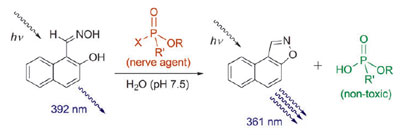| Posted: September 17, 2009 |
Ring closure as warning - new, extremely fast detection of neurotoxins |
|
(Nanowerk News) Soman, Tabun, and Sarin (which has already been used in terrorist attacks) are chemical weapons that attack the nervous system. When inhaled, these extremely toxic organophosphates can lead to death within minutes. The search for fast, simple detection methods for these colorless and odorless gases, which are unfortunately relatively easily manufactured, is correspondingly urgent.
|
|
Julius Rebek, Jr. and Trevor J. Dale at the Scripps Research Institute in La Jolla, California (USA) have now developed a new class of sensors that detect these neurotoxins up to five orders of magnitude faster than previous reagents. As the scientists report in the journal Angewandte Chemie ("Hydroxy Oximes as Organophosphorus Nerve Agent Sensors"), these substances not only selectively detect the neurotoxins, they simultaneously render them harmless.
|
 |
|
Previous detection methods for organophosphates suffer from the fact that they are not sensitive enough, are too complex to use, and cannot be used in the field. In order to overcome these limitations, Rebek and Dale recently developed a new detection agent with a reaction time in the second range, which was still not fast enough. Step by step, they continued to develop their reagent. This has now led to a class of sensors consisting of an aromatic ring system and equipped with an oxime group (–C=N–OH). This type of group binds extremely fast to organophosphates (the researchers carried out their experiments with harmless neurotoxin analogues). Immediately neighboring the oxime group, the molecule has an alcohol group (–OH). This ensures that the reaction product is immediately split off again, which is important because it is as toxic as the original neurotoxin.
|
|
This process involves an intramolecular ring closure. The aromatic ring system promotes the tendency of the sensor to undergo this splitting reaction with ring closure.
|
|
|
|
Furthermore, it provides the actual signal that makes the presence of the organophosphate visible: the ring system is a fluorescent dye, and the fluorescence becomes significantly more intense as soon as the structure of the sensor molecule is changed by the ring closure reaction. This optical detection is four to five orders of magnitude faster than the original detection reagent.
|
|
It should be possible to develop a simple, rapid-response, highly sensitive detection method for organophosphates based on these new reagents. Because the neurotoxins are rendered harmless by the detection reaction, it may also be possible to develop combined devices for the simultaneous detection and neutralization of the toxins.
|

